IPCC Report: A Summary for People
If a picture is worth a thousand words, a 750,000 word IPCC report is logically worth 750 pictures.

By John Lang
Share
Last updated:
Net Zero Tracker lead John Lang is trying out a new way of seeing climate change, one picture at a time.
The length of the latest set of IPCC Sixth Assessment Reports was sanity straining, hitting a record of more than 10,000 pages. When the IPCC produced its maiden assessment of climate change for governments in 1990, it was one-tenth the size — an intimidating but doable 1,000 pages. British chemist Robert Watson allegedly received strict instructions when he sat down to write the opening chapter: “Keep it short.” Author and natural scientist Beatrix Potter would’ve been proud: “the shorter and the plainer the better.”

Does the enormously complex and never-endingly nuanced issue of climate change have to be presented to policymakers, and therefore the public, as the behemoth it actually is? If the proliferation of papers on climate change were used as the measure, the answer would be a resounding yes. IPCC authors, in preparation for this assessment report since the last one in 2013-14, have ploughed through and synthesised the findings from over 230,000 studies.
Like a set of Russian dolls, the IPCC has tried to present its reports in ways that might convince an interested punter — or even a politician — to take the plunge. Its Working Group III Summary for Policymakers came in at a congenial 53 pages or 28,000 words, just under the wordcount of George Orwell’s Animal Farm. Not bad, but not good enough on a planet where (1) climate change is still too often relegated to a sideshow in the circus of life, (2) scrolling Instagram, Facebook and Tiktok are just three of the 100s of rollercoasters on offer before breakfast, and (3) scientific jargon and acronym swamps put up prohibitive barriers to entry.
How, then, could we better get through to apes with smartphones — especially those roaming corridors of power for whom the summaries are really intended?
One way is to treat them like children. John Berger, in Ways of Seeing, reminds us that “Seeing comes before words. The child looks and recognizes before it can speak.” Lynell Burmark, a visual literacy expert, writes that "Unless our words, concepts, and ideas are hooked onto an image, they will go in one ear, sail through the brain, and go out the other ear. Words are processed by our short-term memory where we can retain about seven bits of information. Images, on the other hand, go directly into long-term memory where they're indelibly etched.”
New ways of seeing IPCC reports
Today I released a visual explainer of the latest IPCC assessment report, the second of three I’ll publish before COP27 in Sharm El Sheikh. Since creating one on the IPCC’s Special Report on the Ocean and Cryosphere and another called Worlds Apart based on its Special Report on Global Warming of 1.5 °C, making these has, somewhat counterintuitively, become harder. That’s likely got something to do with the curse of knowledge, a cognitive bias that afflicts communicators of all bents. The problem is that once humans know something — say, the lyrics of a song — we find it increasingly hard to imagine not knowing it. As I’m becoming more knowledgeable, I’m becoming less able to straddle expertise with ignorance. And, as I’m learning, it’s a problem that can’t be solved, only managed.
Because seeing is learning, my hope is that this belated set of infographics (and their individual elements) will be used as visual reference points to help improve climate literacy and support the concise communication of what matters to those who matter. Regardless of a policymaker’s or Joe Public’s scientific literacy, we need more people talking confidently about climate change, because it really is the most important thing you can do.

To the dismay of scientists and policymakers alike, the IPCC is often presented as being a ‘group of scientists’. I set that canard straight first.
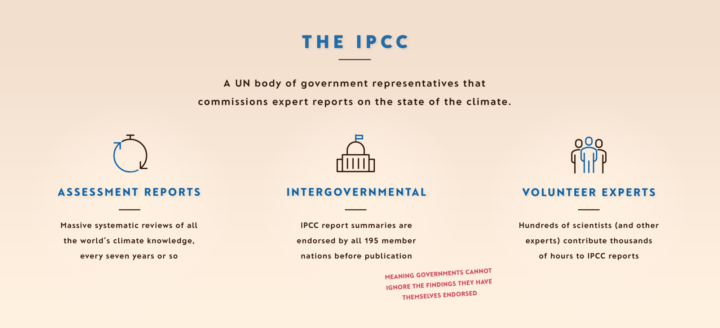
The IPCC communicates scientific uncertainty, inherent in all science, through what it calls ‘calibrated language’. But even with consistent language to guide us, humans find it difficult to gauge the difference between very likely and likely, for example. I don’t blame us. I’m virtually certain this is likely to help.
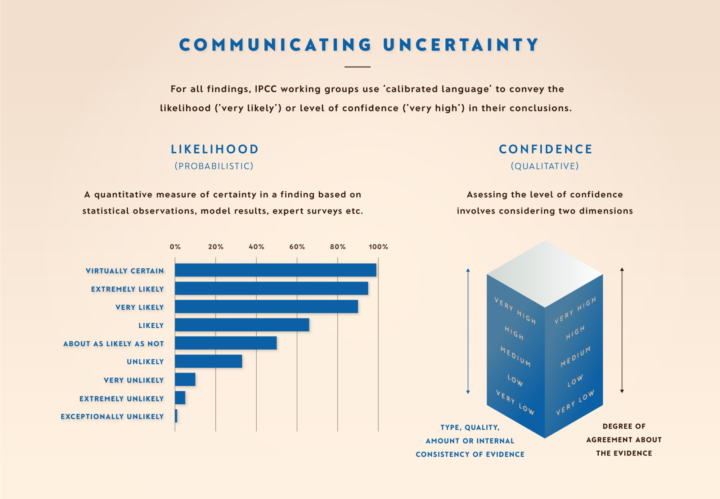
A short timeline of IPCC reports follows, where I make a devastating omission: In 2007 the IPCC shared the Nobel Peace Prize with Al Gore ‘for their efforts to build up and disseminate greater knowledge about man-made climate change, and to lay the foundations for the measures that are needed to counteract such change.’ I’ll be adding it to the next iteration.
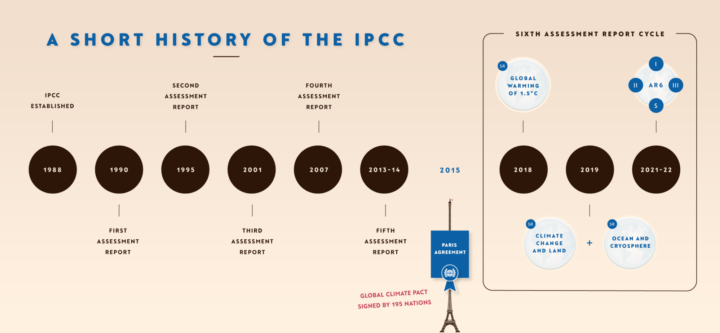
‘Tell ‘Em What You’re Going To Tell ‘Em; Next, Tell ‘Em; Next, Tell ‘Em What You Told ‘Em’. This is where I sum up what the IPCC scientists are saying in three nutshells. Please note the text in the top left corner. It’s important.

A problem well stated is a problem half solved. That’s until you meet climate change: you “almost couldn't design a problem that is a worse fit with our underlying psychology,” says Anthony Leiserowitz, director of the Yale Program on Climate Change Communication. Climate change has no single identity, no single cause, no single solution and no single enemy.
Despite the challenge, I think it still pays to reinforce what might be patronising to some but a prerequisite for others. Purists would be right to point out that the climate problem as presented below is not well stated due to a focus on CO2 at the expense of other greenhouse gases. Very simply, CO2 makes up about 75% of humanity’s heat-trapping emissions and is the gas we must unequivocally drive to net zero as quickly as possible this century. From my experience, focussing on a single cause (CO2) and single solution (net zero), from a communication and problem statement perspective, makes life easier when dealing with a problem as wicked as climate change — at least to begin with. Sometimes, nuance has to wait.

After much internal angst and external debate, I chose to illustrate the weight of human-caused CO2 emissions using Titanics rather than, for example, London double-decker buses. Both are too anglicized, so I’m all ears for a more universally relevant suggestion. The Great Pyramid of Giza?
A crudely crafted rhyme about the slowing annual rate of growth in human-caused CO2 emissions follows. Like so many decarbonisation trends, the direction of travel is encouraging, but the gap between what’s necessary and what’s happening is exasperating.
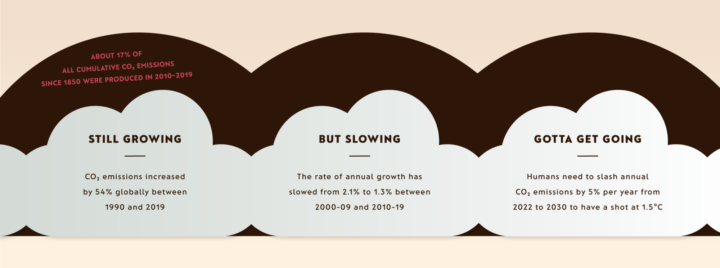
Any climate infographic these days would seem bare without a bath. How do we stop climate change and prevent the bath from overflowing? Going net zero, in all of its naked glory, of course.

‘The Good, the Bad, the Ugly and the Great’ structures what comes next. Granted, it doesn’t roll off the tongue quite like the spaghetti Western title, but one of the golden rules of climate communication is to end on a positive, upbeat tone. Luckily, there really is plenty to be positive about in this report: climate action is accelerating, clean energy is dirt cheap and reducing emissions does not have to compete with economic development. And we haven’t even arrived at The Great yet.
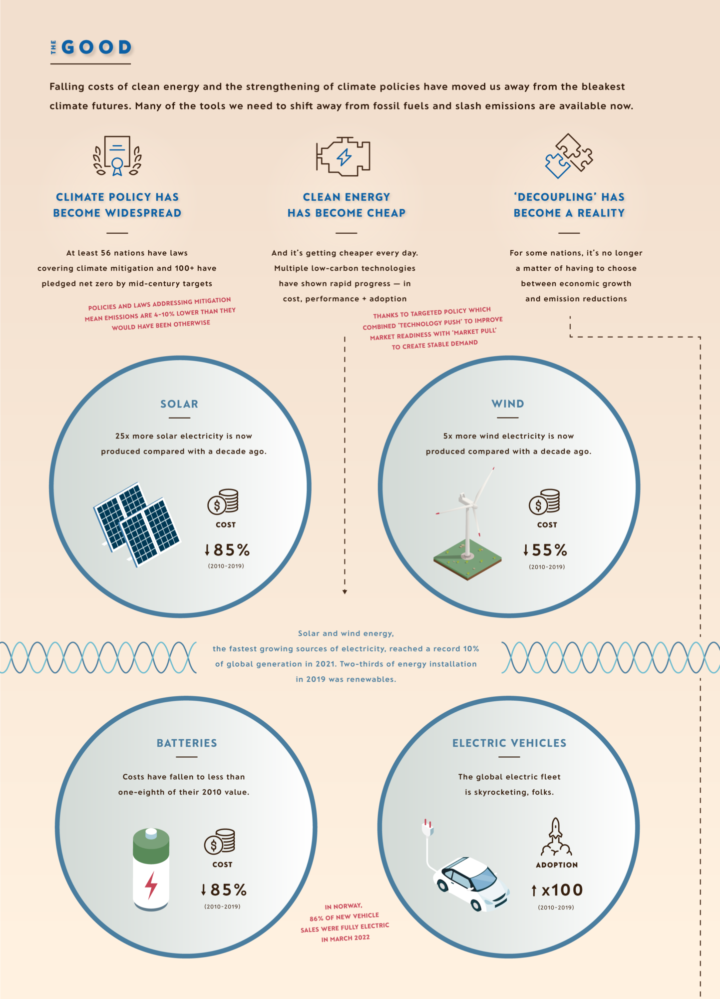
The Bad, and the baddy: fossil fuels.
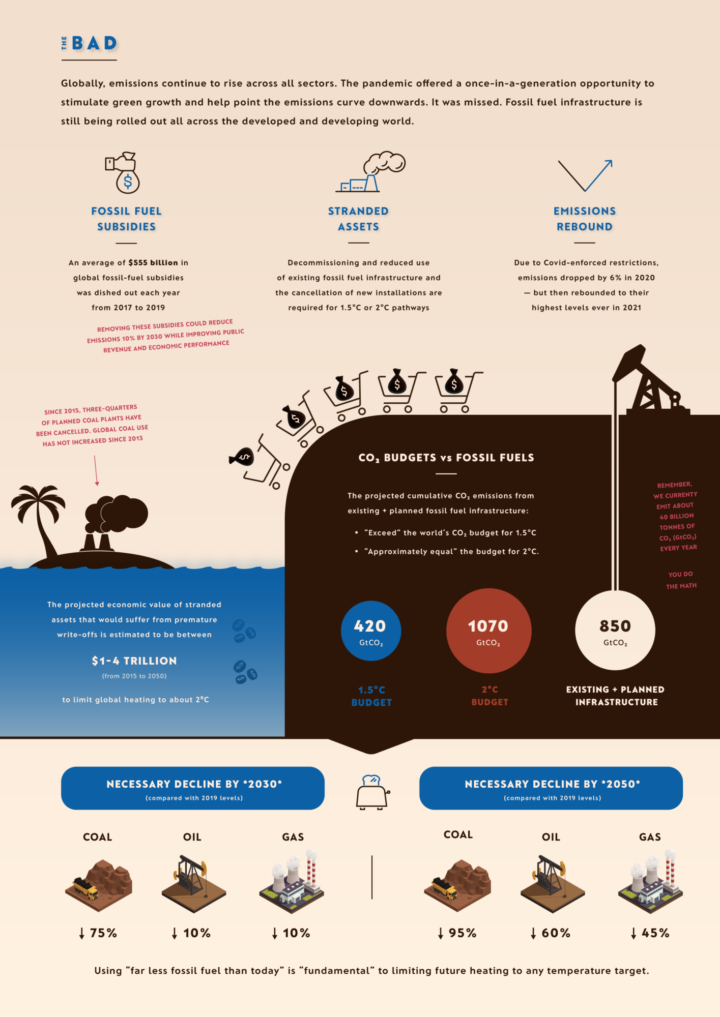
The Ugly. The IPCC tells us in its slides that accompanied the report: ‘We are not on track to limit warming to 1.5°C.’ That’s a profound understatement. The ugliest aspect of climate change, by far, is that the door that was wide open is closing fast.
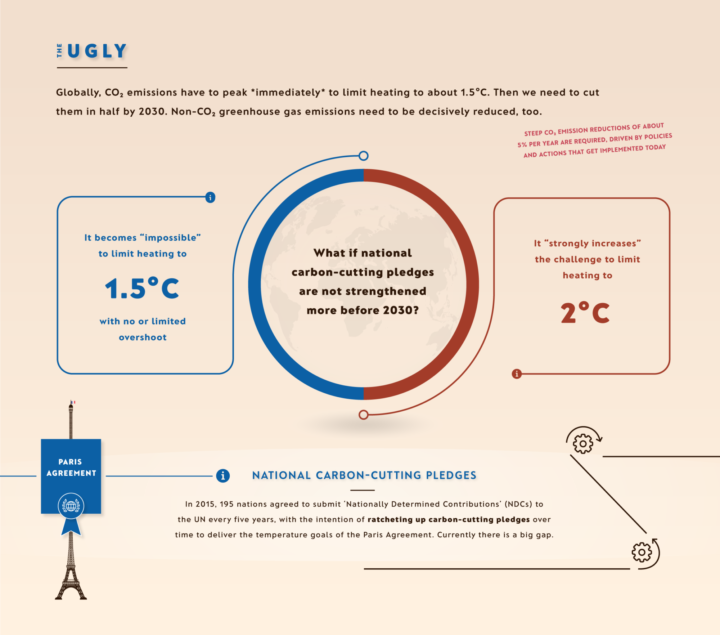
And The Great. It’s simple: stopping climate change will not cost the Earth. In fact, the cost of #notzero is more than the investment required to achieve #netzero
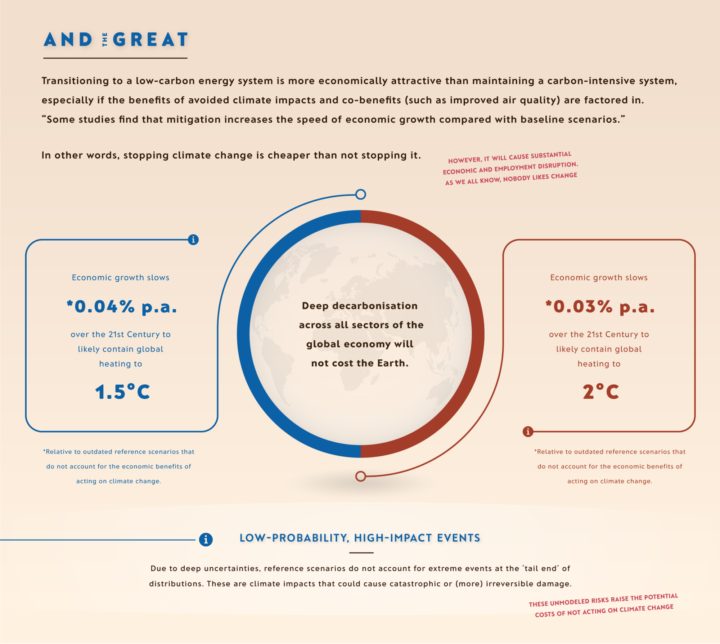
Over the last 30 years of rising climate consciousness, policymakers’ favourite type of policy fruit has tended to be of the low-hanging variety — those that are convenient and cheap. But low-hanging has sometimes turned out to be synonymous with low-impact. Not anymore. As the IPCC stresses, in what is its key message, there are cheap options available now in every sector that can at least halve emissions by 2030.
Convenient and cheap has been joined by carbon-cutting potential.

The Tree of Solutions. One low-hanging fruit a day can keep our emissions at bay.

According to the IPCC, behavioural and cultural changes represented a ‘substantial overlooked strategy’ that have been left out of transition pathways and scenarios for too long. So, I wasn’t about to overlook it. For the record, ‘Buy less crap’ is not positioned at eye level for any particular reason…
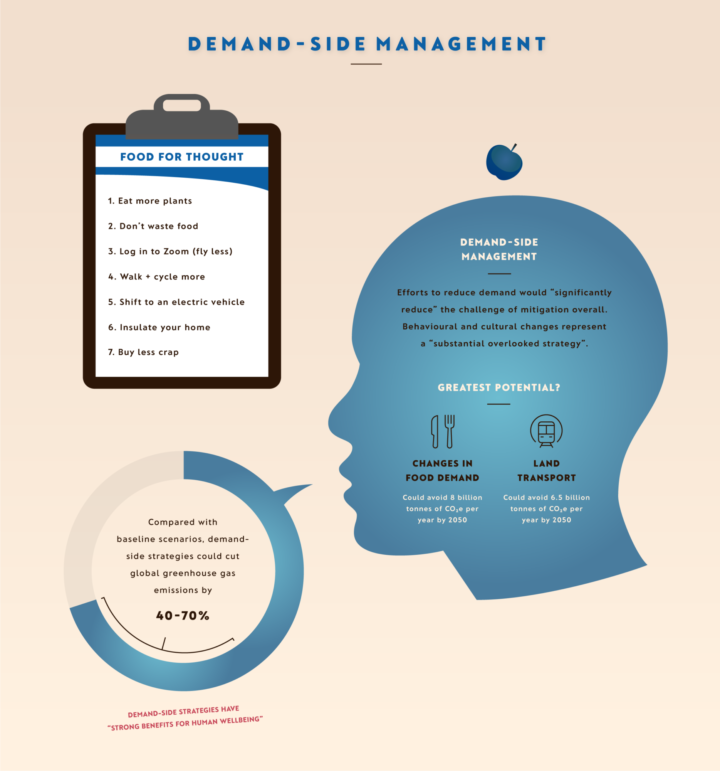
“All models are wrong, some are useful.” Scientific models and storytelling may seem like unlikely bedfellows, but that’s the best way to think about the scenarios the IPCC uses to help us peer into what the future might have in store. Frankly, there is enormous scope to bring these evidence-backed stories to life even more. I had the privilege of working with IPCC scientists to do just that here. Numbers and tables just don’t cut it.
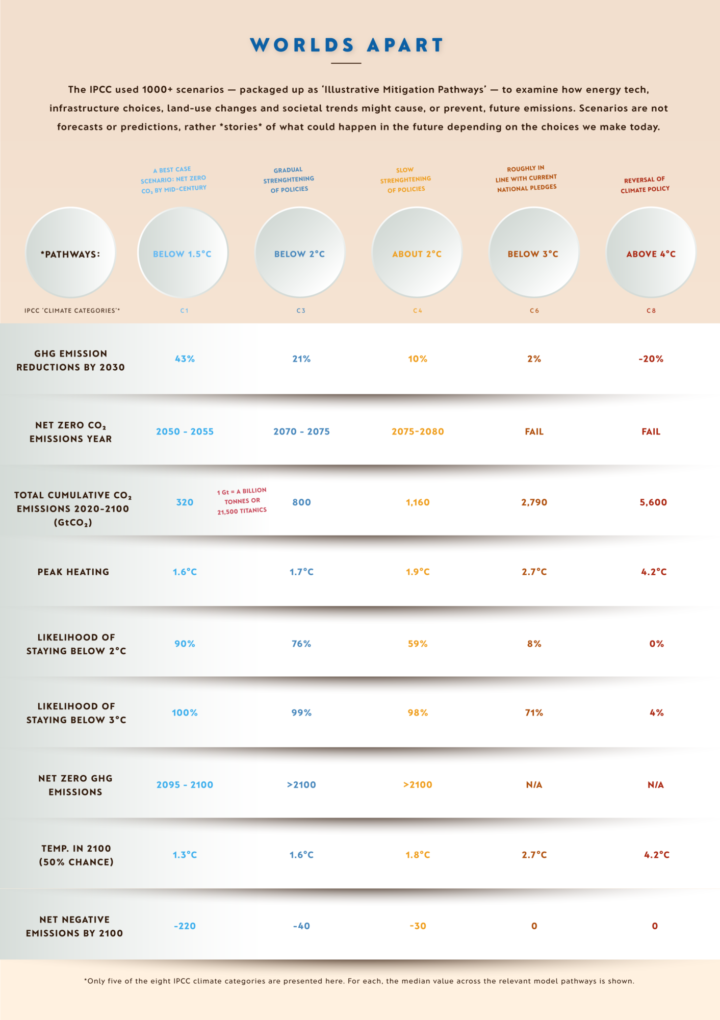
We’re almost there. An oversimplified take on possible climate futures is next. All three, including Christiana Figueres’ ‘necessary, achievable and desirable’ future, have one crucial thing in common: each relies on the decisions we make now and over the next few years.
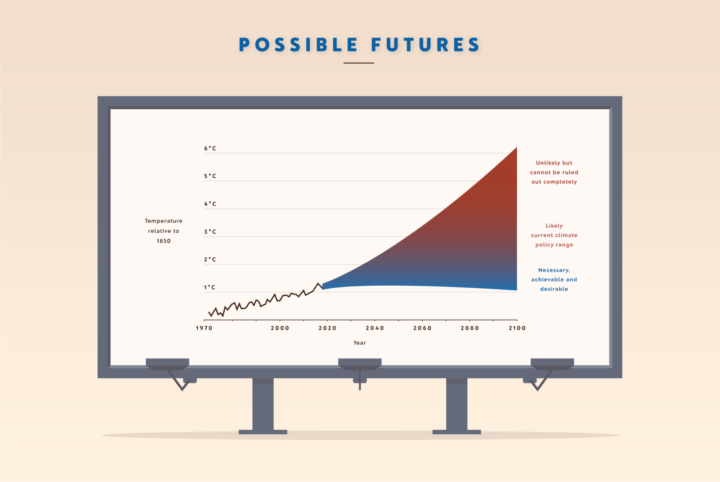
Have you taken a look at the full monty and been wondering why the ‘CO2 Removals Drain’ has been in perpetual freefall? Few beyond those deeply enmeshed in carbon dioxide removal (CDR) know much about it, so I thought it deserved special attention. As the IPCC says, removing CO2 from the atmosphere, both globally and nationally, is “unavoidable” if the world is to reach net zero by mid-century. In other words, everyone is going to need to know more about it at some point soon. (I’m cooking up a dedicated explainer on CDR for the Net Zero Tracker, due for release later this year. Is it a moral hazard or a necessary evil?)
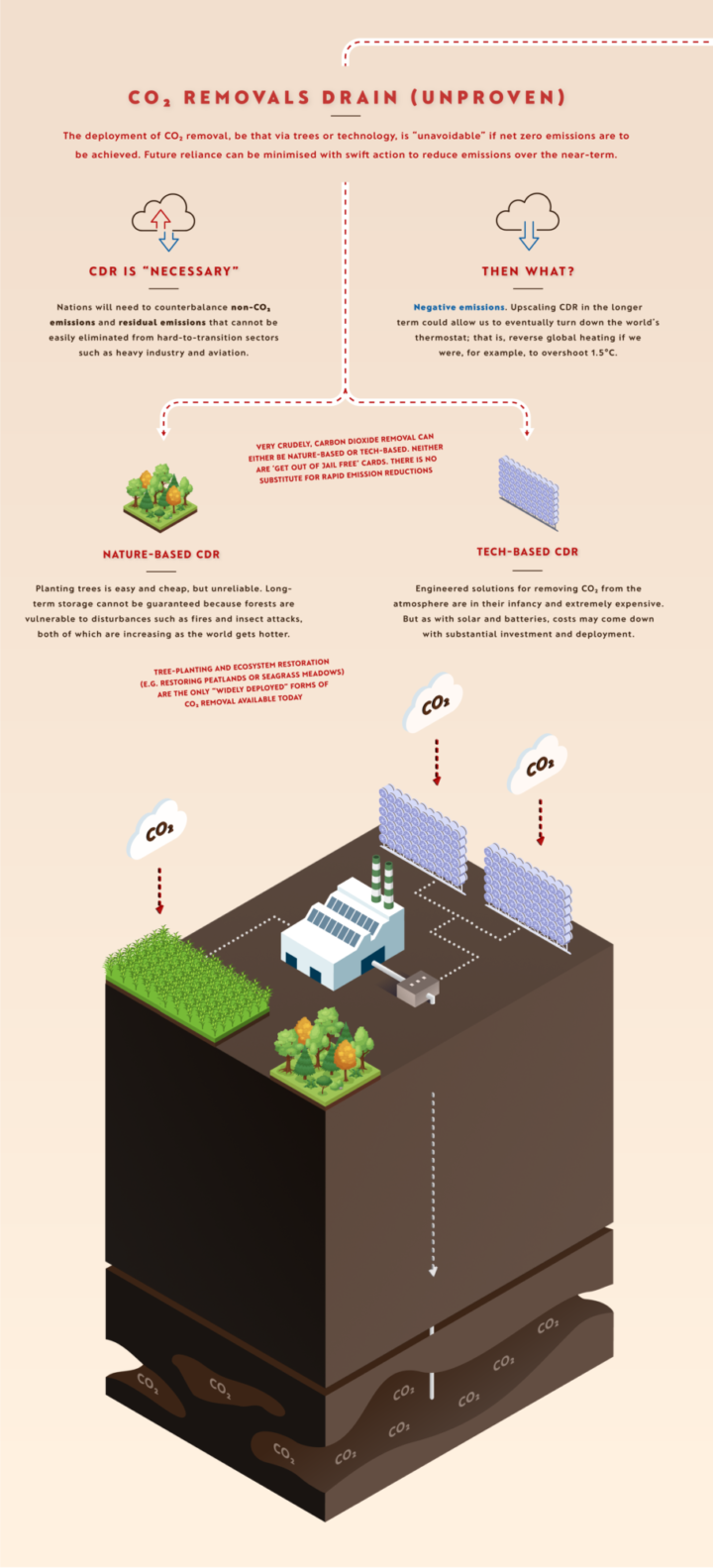
Finally, we arrive at The Bottom Line, inspired by someone who regularly illuminates my Twitter feed with characteristic clarity and level headedness: climate scientist and communicator Zeke Hausfather
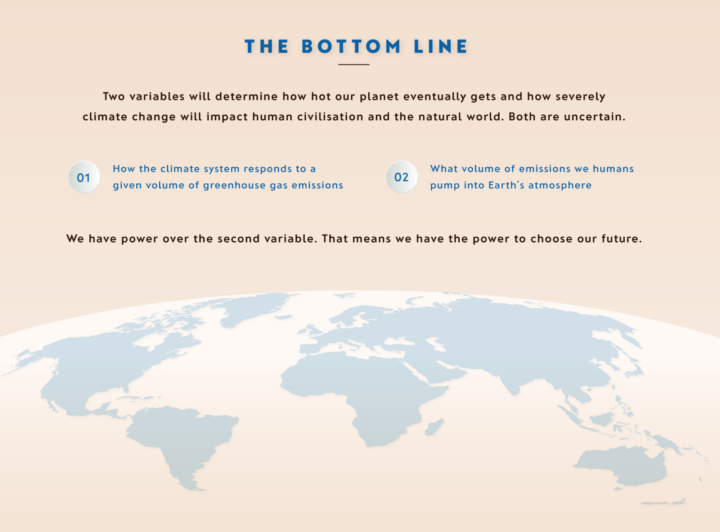
This article first appeared on Skeptical Science.
The full explainer can be viewed here: Stopping Climate Change (IPCC, WGIII)
John also released an explainer on the IPCC's The Physical Science Basis report on August 9 2022, a year after it was published. See more of his work here:
If you fancy using one of the above explainers for yourself (or your classroom), drop John a note over email, Twitter or Linkedin. He can provide them in various formats.